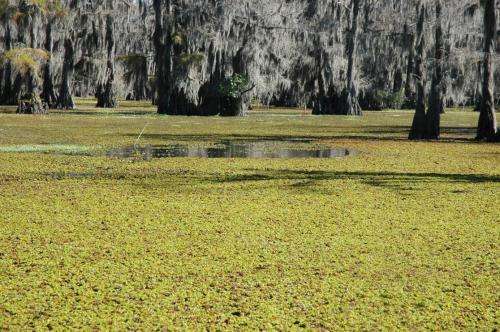Fighting invasive giant salvinia with weevils

Texas A&M AgriLife scientists are seeing significant areas of giant salvinia destroyed by salvinia-eating weevils at Caddo Lake on the Texas-Louisiana border as part of a project evaluating management of the invasive plant, according to scientists.
After releasing approximately 100,000 weevils at two research sites in the last two years, Dr. Allen Knutson, Texas A&M AgriLife Extension Service entomologist at Dallas, and Lee Eisenberg, AgriLife Extension assistant at Karnack for the Texas Water Resources Institute, recently found large mats of salvinia destroyed by the weevils at the sites, Knutson said. Areas adjacent to the release sites show vigorous growth of salvinia, he said.
"I believe we are finally making some progress with the weevils at Caddo, and if these populations overwinter well, we should see an even greater impact next year," Knutson said of their continuing battle to manage giant salvinia at Caddo.
"For the first time since this project began, salvinia weevil populations were established and overwintered, and are now causing significant damage to the mat of salvinia choking Caddo Lake," Eisenberg added.
Giant salvinia appeared on Caddo Lake in 2006 and by late 2013 had spread to cover an estimated 6,000 to 8,000 acres. Giant salvinia is an aggressive, free-floating aquatic fern native to South America that can double in size in four to 10 days under favorable growing conditions. Knutson said the fast-growing plant forms dense mats, which interfere with water recreation, displace native vegetation and reduce oxygen content of the water, often harming fish and other aquatic life.
The plant has invaded 17 Texas lakes and countless other water bodies in the southeastern U.S., Knutson said.
Knutson said the team released 55,000 adult weevils in May and July 2012 at the Bird Roost area of Caddo Lake. Although the weevil population did not increase sufficiently in 2012 to damage the salvinia, Knutson said the weevils were still present in 2013, providing the first evidence that weevils had successfully overwintered. By early November they had destroyed the salvinia mat.
"The mat of dead plants has sunk, revealing open water and only scattered and small salvinia plants survive at this site," he said. "The area of weevil damage is currently estimated at about eight to nine acres.
"This success demonstrates that weevils can overwinter during mild winters at Caddo and have an impact on salvinia infestations," Knutson said.
Eisenberg said samples processed from this site averaged 52 adult weevils per kilogram of sample.
"Our target density to achieve salvinia control is about 40 weevils per kilogram of salvinia, so this target number has been far exceeded and is clear evidence that the mat's destruction is from the weevils released last year," he said.
In another area of the lake, called Lone Pine Stretch, the team released 41,000 weevils in May and July 2013. Knutson said they have observed damage to giant salvinia at this site, but it is not yet as extensive as the impacts seen in Bird Roost.
"This site is only about half an acre in size, but we have also measured a corresponding decline in salvinia biomass of approximately 75 percent at this site," Knutson said. "The damaged area is expected to rapidly expand next year, as it did the second year following weevil releases at Bird Roost."
Weevils are raised at the Center for Invasive Species Eradication's weevil-rearing facility at the U.S. Fish and Wildlife Service's Caddo Lake National Wildlife Refuge. The center is part of the Texas Water Resources Institute, AgriLife Research and AgriLife Extension, and operated in collaboration with Texas Parks and Wildlife Department, the wildlife refuge and the Caddo Lake Institute.
"The rearing facility at Caddo has been critical in providing large numbers of weevils needed to establish populations," Knutson said. "However, patience is required as it takes at least two to three years for weevil populations to increase to effective levels."
Finding strains of salvinia weevils that can overwinter successfully in the climate at Caddo Lake has been an ongoing research topic, Knutson said.
"Our research has demonstrated that populations of salvinia weevils vary in their ability to survive freezing weather," Knutson said. "With these 2012-released weevils surviving the relatively mild winter, we expect the impact of the weevils to continue to grow. However we still need to find cold-tolerant strains of the salvinia weevils that are better adapted to colder climates and reproduce at colder temperatures."
Knutson said they are conducting cold tolerance studies with salvinia weevils from Argentina.
"Weevils in southern, and therefore colder, latitudes in Argentina should be more cold tolerant than those currently in the United States, which were originally collected from Brazil," Knutson said. "Finding more cold-tolerant weevil populations would be especially helpful when colder winters return to East Texas."
The AgriLife entities are investigating ways to control the invasive plant through biological control as well as chemical methods as part of the center's Caddo Lake Giant Salvinia Eradication project, said Lucas Gregory, Texas Water Resources Institute project manager.
"In fact, one of the next objectives is to evaluate the use of biological control and chemical control simultaneously," Gregory said. "Local support has been great and without it, this program would not have been near as effective. People are volunteering time and resources to try and get a handle on the giant salvinia problem."
Robert Speight of the Cypress Valley Navigation District and Daren Horton of Gecko Pest Control have helped with weevil release, Gregory said.
Provided by Texas A&M University


















